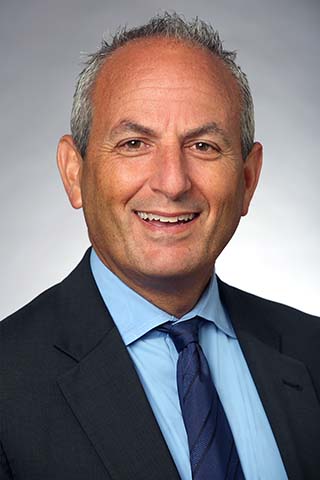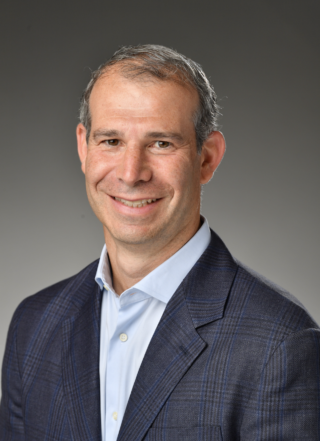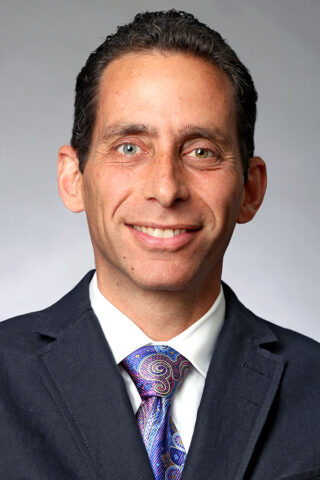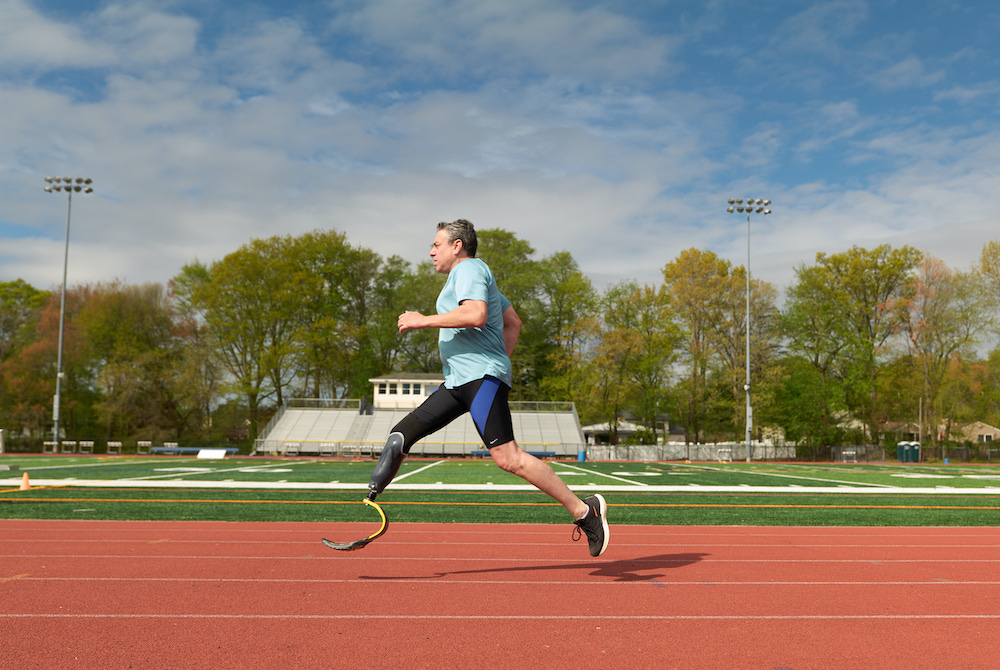How Choosing Amputation Gave a New Jersey Dad His Life Back
After a devastating football injury led to decades of chronic pain, Gary Yerman chose to undergo a specialized amputation at NewYork-Presbyterian/Columbia University Irving Medical Center, allowing him to keep up with his kids — and compete as a triathlete.
Ever since Gary Yerman made the life-altering decision to have a lower leg amputation in 2019, he’s been on the move. Hiking, running, swimming, biking, triathlons — none of it gets old. “My eyes well up after a lot of my runs,” he says. “I just can’t believe I can do this.”
A few years ago, Yerman, 56, could barely walk the aisles of a grocery store without extreme discomfort, let alone train for a triathlon.
In 1983, at the age of 19, he suffered a catastrophic blow to his right leg during a pickup football game, an injury that left him with permanent nerve damage; ever-worsening arthritis in his knee, foot, and ankle; and debilitating chronic pain.
For years, Yerman — a lawyer, New Jersey native, husband, and father of three — fought through pain to remain active with family and friends. Caring for his damaged foot and limb meant countless checkups, scans, and procedures: cortisone shots to relieve inflammation, regular MRIs and X-rays, and surgeries that required weeks of recovery time. In 2001, Yerman underwent an ankle fusion to transform what was a stiff, crooked, painful ankle into a stiff, straight, comfortable one.

Dr. William N. Levine
In 2013, with worsening mobility, Yerman sought the advice and care of Dr. William N. Levine, now chair of orthopedics service at NewYork-Presbyterian/Columbia University Irving Medical Center. Dr Levine encouraged Yerman to see Dr. Justin K. Greisberg, chief of the Foot and Ankle Service at NewYork-Presbyterian/Columbia University Irving Medical Center. And with Dr. Greisberg in 2014, Yerman received a fusion of his lower ankle for worsening arthritis.
A goal of that procedure, says Dr. Levine, was to minimize painful motion occurring in Yerman’s joints.
“The foot was realigned,” Yerman says, “so that it could be flat on the ground and facing forward when I walked.”
A year later, with Dr. Jeffrey A. Geller, chief of orthopedic surgery at NewYork-Presbyterian Lawrence Hospital, Yerman had a full knee replacement. And for a time, Yerman says, the surgeries offered relief. But the effects were temporary.
“The foot just started getting worse and worse,” Yerman says, “to the point that I couldn’t stand up anymore.” So, in 2019 Yerman consulted with Dr. Greisberg on the remaining options available to him: pursuing another fusion for progressive arthritis in the foot, or removing the limb.
“Gary had had many, many surgeries over the years,” Dr. Greisberg says. “You end up with a leg you’ve grown very attached to, because you’ve worked so hard to save it. But it’s like an anchor that holds you back.” His best option, the doctor said — the surgery that could offer him a genuine shot at a full and active life — was amputation.
For patients like Yerman, “amputation can be a reconstructive surgery,” Dr. Greisberg says. “It’s not a loss, or a failure. It’s a way to move on. Sometimes things get so bad that a prosthetic leg is just going to be better than your own ever could be.”
Yerman didn’t need to be persuaded. “I did research, and the upside was tremendous,” he says. “I needed to figure out how I could stand up and play with my kids again, and this really was the only option left.”

Dr. Jeffrey A. Geller
A Life-Changing Injury Occurs
Growing up in New Jersey, Gary Yerman was always chasing something. A ball, a pass, his own personal record — “I loved to run.”
As a boy, he dreamed of running the New York City Marathon. A multisport athlete who loved to go out for long jogs, he signed up for the marathon at 15 and would’ve run it, he says, if not for tweaking his back during a football game. At 17, he left school and joined the Army. While stationed in Germany, he took up boxing, and continued running.
Until Christmas Day 1983. Yerman was playing quarterback in a pickup football game with fellow soldiers. After surveying the field, he decided to sprint for the end zone, when an opponent tackled him from his right. Yerman heard a sickening crack: his leg had snapped in half.
Yerman looked down at his mangled leg in disbelief. His right foot was turned unnaturally inward, so that his right toes pointed completely to the left. “The pain,” he says, “was excruciating.”
Yerman’s fellow soldiers put a board under his leg, lifted him into the back of a Jeep, and set off for the nearest hospital. Twenty-four hours later, Yerman was transferred to an Army hospital in Frankfurt. There he learned the extent of his injuries. All but one major ligament in his right knee had been destroyed, the cartilage shredded. Worse, a key nerve in his leg had been partially severed.
Medically evacuated to Walter Reed Army Hospital in Maryland, Yerman spent the next nine months in rehab, six of them in a cast that spanned from his hip to his toes. “I was in a wheelchair and didn’t really feel anything,” he says. “I didn’t know the severity of it.”
Once the cast came off, however, Yerman quickly realized his leg would never be the same. “The only thing I could do with my foot was move it inward, not up or out,” he says. For the next 17 years, he wore an ankle foot orthotic (AFO), an awkward brace that kept his ankle locked at 90 degrees.
Yerman says he never sat down and mourned. “You just go on with your life and you deal with it,” he says. And yet, for Yerman, so much changed.
After he was discharged from the Army, Yerman enrolled at the University of Maryland. Crossing campus left him in agony. Yerman tried to keep up with his friends, wearing a brace through basketball games and short runs. But the orthotic “would cut into me,” Yerman says. “I’d get home and take it off, and the pain would be so bad.”
Slowing Down, But Never Giving Up
Over time, reluctantly, Yerman learned to slow down. “I had to teach myself to take it easy.”
He also became an expert at hiding his pain. In 2003, Yerman married fellow attorney Megan Smollik after meeting at work at a New York City law firm. But for years, Smollik says, she didn’t realize the extent of her husband’s discomfort. “He did such a good job of hiding it,” she says. “I realized, this is a strong guy, he’s proud, he doesn’t want sympathy. He had a handicap parking placard, but never used it unless there were no spots left. He always thought there would be somebody more deserving of that spot. He didn’t want to think of himself as disabled.”
Yerman and Smollik went on to have three children: sons Reese, now 12, and Blake, 10, and daughter Dylan, 7. As the years wore on and Yerman’s arthritis grew worse, says Smollik, it became harder for him to hide his discomfort. “There would be a crabbiness, an irritability,” she says. “It became obvious to me at some point how much pain he was in. It was just constant.”
Yerman rarely spoke of the emotional toll from the pain. But every so often, Smollik says, she picked up on it. “The kids and I went out for a hike one time, over Labor Day weekend. Gary stayed home. We had a lot of fun, got a lot of nice pictures. When I was showing him the photos, I could just see a look on his face,” she remembers.
Over the years, he mulled over the possibility of having his leg and foot amputated. But he continued to hold out hope that he wouldn’t need to. “I thought they might come up with a cure,” he says.
And so he waited.
Until 2019. Something shifted for Yerman one afternoon that spring, while he was watching his sons, then 10 and 8, toss a ball in the backyard.
The boys had pleaded with Yerman to come out and play. “I remember sitting on the couch and thinking, ‘I can’t,’” he recalls. “It just bothered the heck out of me. I didn’t want to go through life sitting and watching them play. I wanted to participate.”
Within weeks, Yerman visited Dr. Greisberg at NewYork-Presbyterian/Columbia University Irving Medical Center and told him he was ready.

Dr. Justin K. Greisberg
Undergoing an Amputation
From their conversations over the years, Dr. Greisberg knew how Yerman yearned to be able to play with his children again.
When reviewing Yerman’s surgical options, he spoke to him about the Ertl technique, a variation on a traditional transtibial amputation — removal of the leg from the center of the shin bone down — that would help him pursue activities like jogging.
In the procedure, a surgeon connects the tissue between the fibula and tibia, creating a strong, flat, bony bridge that, when healed, can distribute the body’s weight more evenly.
“It’s designed for people who want to be athletic,” Dr. Greisberg says. “It makes the fibula more stable, and gives you a bigger platform to put your weight on.”
For weeks leading up to Yerman’s surgery, Dr. Greisberg worked to prepare Yerman and his wife for what Yerman’s surgery and recovery would hold, and what life with a prosthesis might look like. “As with any irreversible surgery,” says Dr. Greisberg, “there’s a certain degree of getting the patient’s psychology ready.” He fielded their questions and introduced them to a prosthetist.
But Dr. Greisberg could see that Yerman was motivated. “He was 100% on board,” he says. Yerman jumped into a new strength-training routine, lifting weights a few times a week to build up his atrophied right side and prepare himself to walk on his new prosthetic leg. “He had his eye on the goal.”
Yerman’s hard work paid off. Within days of his discharge, he was practicing pushups with a physical therapist.
“As surgeons, especially orthopedic surgeons, we’re about restoring anatomy and restoring function. That’s what we do,” says Dr. Levine. But for Yerman, continuing to reconstruct his damaged, suffering limb was not the ultimate path to healing. “Here is an example of where taking away this young man’s pain, giving him the opportunity to get a prosthesis and become reborn in a way, metaphorically speaking, is quite remarkable,” Dr. Levine says.
Yerman was giddy, testing the limits of his body. “I was just pushing myself, seeing what I could do,” he says. “I found out I could do a lot.”

Going the Distance
By summer 2020, six months after his surgery, Yerman began experimenting with a specialized prosthetic running blade. Every other day, he tried running around his local track, one lap, and then another and another.
Teaching himself how to run again was “easily one of the most difficult things I’ve had to do,” he says. “It feels like running on your tiptoes. You have to figure out how much weight to put on your leg, how long to stay on it, how to push off.”
By that September, Yerman could do a mile around the track. On his birthday, September 28, he ran three in a row. “I was just in tears,” Yerman says. “That’s when I started to think, maybe there’s other stuff I could do.”
Since then, Yerman has competed in three sprint-distance triathlons, each involving a half-mile swim, 15-mile bike ride, and 3.2-mile run. Yerman has a coach who helps him during race transitions, swapping out his racing prostheses, which include a walking leg fitted with a bike shoe, and his running blade. (He doesn’t need a prosthesis for the swim portion.)
Yerman no longer spends his days clenching his teeth through pain. But his athletic pursuits have tested his grit in new and dramatic ways.
During his second triathlon last summer, in Atlantic City, his running blade snapped, sending him crashing to the ground. With his arms slung around the shoulders of his coach and a fellow competitor, he hopped on one leg through the rest of the race, three-quarters of a mile. “There was no way,” he says, “that I wasn’t getting to that finish line.”
Hearing Yerman recount the story during a follow-up appointment, Dr. Greisberg had to marvel.
“He’s just an exceptional individual,” Dr. Greisberg says. “He’s taken the second chance he’s been given and really taken advantage of it. I am proud to know Gary, and I am so thrilled that I could play some part in his success.”
A second chance he might not have had, Yerman says, if not for the care he received from his surgical team at NewYork-Presbyterian/Columbia University Irving Medical Center. “Without my surgeon, without the perfect surgery that he performed, I wouldn’t have gotten this chance,” he says. “The doctors, the nurses, the prosthetists, they gave me an opportunity to see how far I could go.”
“I’m not religious, but it’s like being born again,” Yerman says. “You have an opportunity to do things that you never even dreamed about.”
Especially with his kids. Being an example to them, Yerman says, “is all I care about.”
“Whenever I’m finishing a race, I think about my children,” Yerman says. “Hopefully, they’re watching me. I want them to know there’s no quit in us.”

